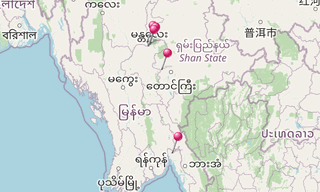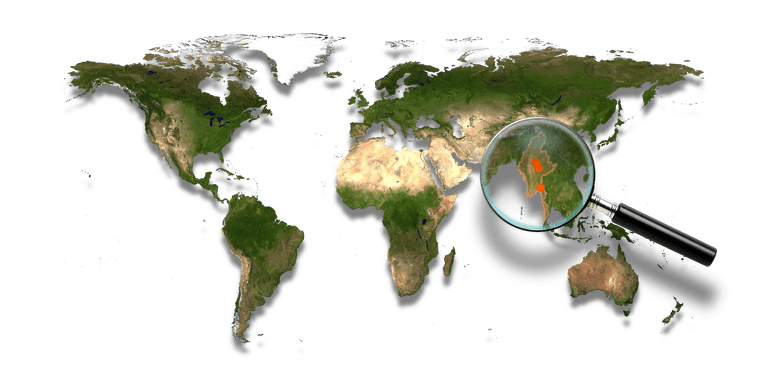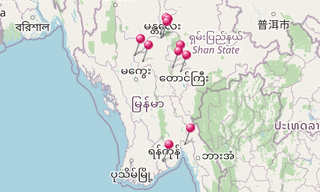Other sites in Myanmar:
Kuthodaw Pagoda
Kuthodaw Pagoda is a Buddhist stupa, located in Mandalay, that contains the world’s largest book. It lies at the foot of Mandalay Hill and was built during the reign of King Mindon. The stupa itself, which is gilded above its terraces, is 57 m high, and is modelled after the Shwezigon Pagoda at Nyaung-U near Bagan. In the grounds of the pagoda are 729 kyauksa gu or stone-inscription caves, each containing a marble slab inscribed on both sides with a page of text from the Tipitaka, the entire Pali Canon of Theravada Buddhism.
Kyaiktiyo Pagoda
Kyaiktiyo Pagoda (also known as Golden Rock) is a well-known Buddhist pilgrimage site in Mon State. It is a small pagoda (7.3 m) built on the top of a granite boulder covered with gold leaves pasted on by devotees. According to legend, the Golden Rock itself is precariously perched on a strand of the Buddha’s hair.
The balancing rock seems to defy gravity, as it perpetually appears to be on the verge of rolling down the hill. The rock and the pagoda are at the top of Mt. Kyaiktiyo. It is the third most important Buddhist pilgrimage site in Burma after the Shwedagon Pagoda and the Mahamuni Pagoda.
Mingun Pahtodawgyi
The Mingun temple is a monumental uncompleted stupa began by King Bodawpaya in 1790. It was not completed, due to an astrologer claiming that, once the temple was finished, the king would die. The completed stupa would have been the largest in the world at 150 m. Huge cracks are visible on the structure from the earthquake of 23 March 1839. Like many large pagodas in Myanmar, a pondaw paya or working model of the stupa can be seen nearby.
Mount Popa
Mount Popa is a volcano 1518 m above sea level, and located in central Myanmar about 50 km southeast of Bagan (Pagan) in the Pegu Range. It can be seen from the Ayeyarwady (Irrawaddy) River as far away as 60 km in clear weather. Mount Popa is perhaps best known as a pilgrimage site, with numerous Nat temples and relic sites atop the mountain.
Pindaya Caves
The Pindaya Caves, located next to the town of Pindaya, Shan State, are a Buddhist pilgrimage site located on a limestone ridge in the Myelat region. There are three caves on the ridge which runs north-south, but only the southern cave can be entered and explored.
It is not known whether the other two penetrate for any extended distance into the hillside. The southernmost Pindaya cave extends for about 150 m along a well-worn path. It is known for its interior which contains over 8,000 images of Buddha. Some of the older statues and images in the cave have inscriptions dating to the late 18th century, or early Konbaung period, and the earliest one dates from 1773.
Shwenandaw Monastery
Shwenandaw Monastery is a historic Buddhist monastery located near Mandalay Hill. Shwenandaw Monastery was built in 1878 by King Thibaw Min, who dismantled and relocated the apartment formerly occupied by his father, King Mindon Min, just before Mindon Min’s death, at a cost of 120,000 rupees.
Thibaw removed the building in 10 October 1878, believing it to be haunted by his father’s spirit. The building reconstruction was finished in 31 Oct 1878, dedicated in memory of his father, on a plot adjoining Atumashi Monastery. The monastery is known for its teak carvings of Buddhist myths, which adorn its walls and roofs.
The monastery is built in the traditional Burmese architectural style. Shwenandaw Monastery is the single remaining major original structure of the original Royal Palace today.
Shwezigon Pagoda
The Shwezigon Pagoda or Shwezigon Paya is a Buddhist temple located in Nyaung-U, a town near Bagan, in Myanmar. A prototype of Burmese stupas, it consists of a circular gold leaf-gilded stupa surrounded by smaller temples and shrines. Construction of the Shwezigon Pagoda began during the reign of King Anawrahta (1044–77), who was the founder of the Pagan Dynasty, in 1059–1060 and was completed in 1102 AD, during the reign of his son King Kyansittha. Over the centuries the pagoda had been damaged by many earthquakes and other natural calamities. This pagoda, a Buddhist religious place, is believed to enshrine a bone and tooth of Gautama Buddha.

-Golden-Rock-Kyaiktiyo-Pagoda.hero.landscape.jpg?w=1600)


-Pindaya.jpg?w=256)
-U-Bein.jpg?w=256)
-Kalaw.jpg?w=256)
-Golden-Rock-Kyaiktiyo-Pagoda.jpg?w=256)
-Mawlamyaing.jpg?w=256)
-Mingun.jpg?w=256)
-Mawlamyaing.jpg?w=256)
-Mingun.jpg?w=256)
-Shwenandaw.jpg?w=256)
.jpg?w=256)
-Mount-Zwegabin.jpg?w=256)
-Mandalay.jpg?w=256)
-Shwenandaw.jpg?w=256)
-Kuthodaw.jpg?w=256)
.jpg?w=256)
-Mandalay.jpg?w=256)
-Pindaya.jpg?w=256)
-Kalaw.jpg?w=256)
-Kalaw.jpg?w=256)
-Mahamuni.jpg?w=256)
-Pindaya.jpg?w=256)
-Kalaw.jpg?w=256)
-Mount-Zwegabin.jpg?w=256)
-Kalaw.jpg?w=256)
-Shwenandaw.jpg?w=256)
-Shwenandaw.jpg?w=256)
-Mandalay.jpg?w=256)
-Kalaw.jpg?w=256)
-Pindaya.jpg?w=256)
-Mingun.jpg?w=256)
-Mahamuni.jpg?w=256)
-Shwenandaw.jpg?w=256)
-Mandalay.jpg?w=256)
-Golden-Rock-Kyaiktiyo-Pagoda.jpg?w=256)
-Mawlamyaing.jpg?w=256)
-Mandalay.jpg?w=256)
-U-Bein.jpg?w=256)
-Mawlamyaing.jpg?w=256)
-Mount-Zwegabin.jpg?w=256)
-Mawlamyaing.jpg?w=256)
-Golden-Rock-Kyaiktiyo-Pagoda.jpg?w=256)
-Kalaw.jpg?w=256)
-Golden-Rock-Kyaiktiyo-Pagoda.jpg?w=256)
-Mingun.jpg?w=256)
-Mandalay.jpg?w=256)
-Mingun.jpg?w=256)
-Kuthodaw.jpg?w=256)
-Pindaya.jpg?w=256)
-Mandalay.jpg?w=256)
-Golden-Rock-Kyaiktiyo-Pagoda.jpg?w=256)
-Mawlamyaing.jpg?w=256)
-Shwenandaw.jpg?w=256)
-Kalaw.jpg?w=256)
-Kalaw.jpg?w=256)
-Mandalay.jpg?w=256)
-Shwedagon.hero.jpg?w=320)
